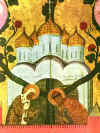Simeon Ushakov's Icon of the "Tree of the Muscovite State"
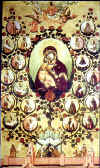 In
1634, a wealthy Moscow merchant (formerly a resident of Iaroslavl'), Grigorii Nikitnikov,
sponsored the construction of a church dedicated to the Holy Trinity in the Kitai-Gorod
region not far from Red Square in the center of Moscow. Many of the best known
painters of the time worked on the interior decoration, among them Simeon Ushakov, the
most prominent of the painters in the Kremlin workshops. In 1668, Ushakov painted
for the church this icon, which embodies important aspects of the official religious and
ideological program of the Muscovite state in the middle of the seventeenth century.
In
1634, a wealthy Moscow merchant (formerly a resident of Iaroslavl'), Grigorii Nikitnikov,
sponsored the construction of a church dedicated to the Holy Trinity in the Kitai-Gorod
region not far from Red Square in the center of Moscow. Many of the best known
painters of the time worked on the interior decoration, among them Simeon Ushakov, the
most prominent of the painters in the Kremlin workshops. In 1668, Ushakov painted
for the church this icon, which embodies important aspects of the official religious and
ideological program of the Muscovite state in the middle of the seventeenth century.
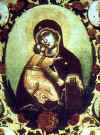
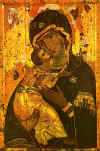 The center of the icon (left)
reproduces the famous "Icon of the Vladimir Mother of God"(shown on right), a
twelfth-century Byzantine painting which, according to tradition, had been brought to
Vladimir by Andrei Bogoliubskii. Tradition further had it that when Moscow was
threatened by Tamerlane's armies in 1395, the icon was brought to the city from Vladimir
and thus Moscow was spared destruction. The icon thus came to be considered the most
important of the miracle-working icons associated with Moscow and eventually was moved
permanently to the Cathedral of the Dormition in the Moscow Kremlin. Its
significance was the equivalent to that of the icon of the "Virgin of the Sign"
in Novgorod, which was considered to have defended Novgorod against the army of
Bogoliubskii in 1169. Countless copies of the icon of the Vladimir Mother of God
circulated in Muscovy.
The center of the icon (left)
reproduces the famous "Icon of the Vladimir Mother of God"(shown on right), a
twelfth-century Byzantine painting which, according to tradition, had been brought to
Vladimir by Andrei Bogoliubskii. Tradition further had it that when Moscow was
threatened by Tamerlane's armies in 1395, the icon was brought to the city from Vladimir
and thus Moscow was spared destruction. The icon thus came to be considered the most
important of the miracle-working icons associated with Moscow and eventually was moved
permanently to the Cathedral of the Dormition in the Moscow Kremlin. Its
significance was the equivalent to that of the icon of the "Virgin of the Sign"
in Novgorod, which was considered to have defended Novgorod against the army of
Bogoliubskii in 1169. Countless copies of the icon of the Vladimir Mother of God
circulated in Muscovy.
While the composition of the icon draws upon two important models--one
being icons of the "Veneration of the Mother of God" and the other being the
"Tree of Jesse," which shows the Old Testament genealogy of the forebears of
Christ--in Ushakov's rendering, it bears features very specific to Muscovy. At the
bottom can be seen very realistically rendered walls of the Moscow Kremlin, with the
Frolov (Savior) gate that leads into Red Square just left of center. The trunk of
the tree grows out of the Cathedral of the Dormition in the Kremlin. The planting
and watering of the tree are being done by the founders of the Muscovite state,
Metropolitan Peter and Grand Prince Ivan I. The Romanovs are also represented
though. Taking part in the veneration of the Vladimir icon are the reigning Tsar
Aleksei Mikhailovich, and (as shown in the detail) his wife, Mariia Miloslavskaia, and two
sons, Ivan and Fedor. The scroll she holds contains verses from the service hymns to
the Virgin, as do the scrolls held by the other figures in the composition.
The left side of the tree has medallions with images of Muscovite
Metropolitans and Tsars. From bottom to top, they include in ascending chronological
order: Metropoitans Aleksei, Kiprian, Fotii, Iona, Filipp (a victim of Ivan IV's Oprichnina),
and Patriarch's Filaret (the father of Aleksei Mikhailovich) and Iov. At the top of
the sequence are Tsars Fedor Ivanovich (the last of the Riurikid branch of the Moscow line
to rule, d. 1598), Mikhail Fedorovich (the first of the Romanovs and the father of Aleksei
Mikhailovich) and Tsarevich Dmitrii (the son of Ivan IV who died in mysterious
circumstances in Uglich in 1591). Notable by their absence are figures such as
Metropolitan Isidore, who betrayed the one true faith by agreeing to recognize the
authority of the Pope at the Council of Florence in 1439, Ivan IV, Boris Godunov, Vasilii
Shuiskii, and Patriarch Nikon (who fell out with Aleksei Mikhailovich and was stripped of
his see just before this icon was painted). The chief hierarchs of the church are
thus well represented, less notables such as Daniil and Makarii from the sixteenth
century); the princely family only partially represented, but clearly with the intention
of emphasizing the Romanovs and continuity with the old dynasty.
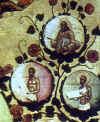 The
right side of the composition is a series of monastic saints and iurodivye (Fools
in Christ). From bottom to top they are the prince-monk Aleksandr Nevskii (who was
actually canonized), Sergii of Radonezh (the patrion saint of the ruling family), Nikon of
Radonezh, Pafnutii of Borovsk, Simon and Andronik (disciples of Sergii of Radonezh), and iurodivye
Maksim the Blessed, Basil the Blessed (associated with the church in Red Square) and Ivan
"Large Cap." A detail of these last three is on the right.
The
right side of the composition is a series of monastic saints and iurodivye (Fools
in Christ). From bottom to top they are the prince-monk Aleksandr Nevskii (who was
actually canonized), Sergii of Radonezh (the patrion saint of the ruling family), Nikon of
Radonezh, Pafnutii of Borovsk, Simon and Andronik (disciples of Sergii of Radonezh), and iurodivye
Maksim the Blessed, Basil the Blessed (associated with the church in Red Square) and Ivan
"Large Cap." A detail of these last three is on the right.
We can see in Ushakov's composition then at least one version of the way
in which the Romanovs and the Church in the seventeenth century construed what was
important in the history of Muscovy. The beginnings are associated with Ivan I (not
his father or grandfather), since Ivan was the one who began the tradition that continued
almost unbroken that the princes of Moscow would also be Grand Princes of Vladimir.
The connection with Vladimir is emphasized by the focus of the composition,
the Vladimir Mother of God. Moscow also was the seat of the Russian church,
beginning with Peter, who was buried there and following whom the metropolitanate moved
there. Church and state develop in harmony and mutual support of one another.
One might speculate that the icon was painted in part precisely because of the Nikon
affair. Nikon's reforms, supported by the Tsar, had led to the Church Schism, but
then they quarreled over the issue of spheres of jurisdiction, with Nikon's contesting
decisions the Tsar had made regarding some church appointments. Nikon stalked out in
a huff, for several years the Church functioned without an active Patriarch, and finally
in 1666-1667, a church council met which condemned the Old Believers (schismatics), thus
ironically confirming Nikon's reform program at the same time that it removed Nikon from
office. Presumably there was a strong interest in Moscow in reaffirming Church unity
and the symphony of Church and State.
© 2000 Daniel C. Waugh
 In
1634, a wealthy Moscow merchant (formerly a resident of Iaroslavl'), Grigorii Nikitnikov,
sponsored the construction of a church dedicated to the Holy Trinity in the Kitai-Gorod
region not far from Red Square in the center of Moscow. Many of the best known
painters of the time worked on the interior decoration, among them Simeon Ushakov, the
most prominent of the painters in the Kremlin workshops. In 1668, Ushakov painted
for the church this icon, which embodies important aspects of the official religious and
ideological program of the Muscovite state in the middle of the seventeenth century.
In
1634, a wealthy Moscow merchant (formerly a resident of Iaroslavl'), Grigorii Nikitnikov,
sponsored the construction of a church dedicated to the Holy Trinity in the Kitai-Gorod
region not far from Red Square in the center of Moscow. Many of the best known
painters of the time worked on the interior decoration, among them Simeon Ushakov, the
most prominent of the painters in the Kremlin workshops. In 1668, Ushakov painted
for the church this icon, which embodies important aspects of the official religious and
ideological program of the Muscovite state in the middle of the seventeenth century.


